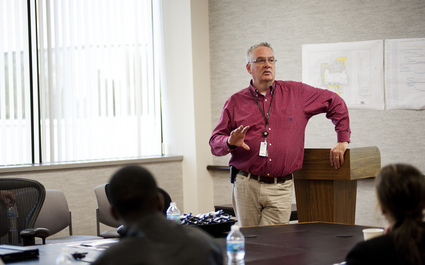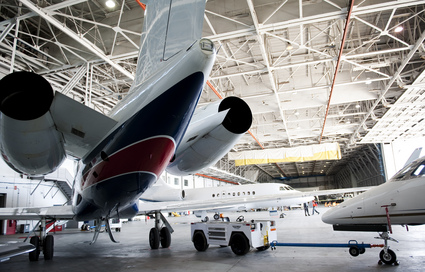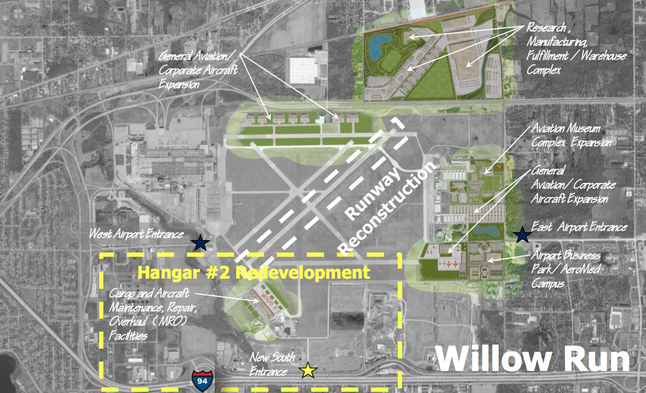
The view from the old control tower Tuesday of the Willow Run Airport on the border of Ypsilanti and Van Buren townships. The airport is planning to reconstruct and reconfigure its 70-year-old runways -- built for WWII bombers -- over the next 10 years.
Daniel Brenner | AnnArbor.com
- Related coverage: GM Willow Run plant redevelopment: Active discussions in progress with several companies
Willow Run Airport on the Ypsilanti Township border will be seeking $182 million in changes to its runways and infrastructure throughout the next 10 years, provided airport authorities attract the grant money they need to make the projects possible.
“Willow Run’s at a crossroads,” said Sean Brosnan, director of the Willow Run Airport.
Brosnan presented the 10-year plan for the airport in front of an audience of U.S. Rep. John Dingell, D-Mich., Washtenaw County officials and key economic development players including representatives from Ann Arbor SPARK and the Detroit Region Aerotropolis.
“We have here a tremendous potential asset -- or a group of assets; One of which is, of course, the airport facility itself,” Dingell said.
The upgrades will be important as the airport is being used as a marketing tool to attract developers to the adjacent former General Motors Willow Run plant and the Aerotropolis region between Willow Run and Detroit Metro airports.
The future of the airport is vitally important to Ypsilanti Township because of the kinds of new businesses it could bring in to the area, said Washtenaw County Commissioner Rolland Sizemore Jr., D-Ypsilanti Township. Cargo businesses located at the airport include Kalitta Air, USA Jet, Ameristar Jet Charter, Active Aero and National Airlines.

Sean Brosnan, director of the Willow Run Airport, speaks to a group of officials working in Washtenaw and Wayne counties Tuesday at a boardroom in the former GM plant.
Daniel Brenner | AnnArbor.com
The first phase of construction has received funding from the Federal Aviation Administration: An $18 million grant has been allocated to reconstructing the northern half of its main, 7,525-foot-long runway.
Together with a 5 percent match from the state of Michigan and a 5 percent match from the Wayne County Airport Authority, the $20 million project is the first step in an overhaul the airport plans for its aging facilities. Construction is slated to begin in May, and last through Nov. 15.
To completely reconstruct the main runway, an additional $23 million is needed. Brosnan said the airport is “shovel ready” to reconstruct the southern half of the main runway should they be awarded additional grant funding.
This year, Willow Run Airport also will be upgrading its precision-aided pilot instrumentation systems on the runway parallel to its main runway to accommodate the plane traffic during construction.
Throughout the next 10 years, the airport is planning to add taxiways to make the airport more efficient for planes to use.
“The previous congressmen who represented this year didn’t want to extend the runways - which may be a component of making this a workable air transport facility,” Dingell said, adding in regards to the federal budget sequester: “This is all going to cost a lot of money that’s being hurt by the awful mess that we have in Washington.”
The runway on the north side of the airport that runs parallel to Ecorse Road will be reconstructed about three years before it is extended from 7,200 feet to 9,550 feet long, Brosnan said.
The extension is slated to happen in 2023, according to the airport’s 10-year plan.
The runway expansion will be a significant change in the kinds of capabilities Willow Run Airport is able to offer its clients in the cargo business, Brosnan said.
“This will allow us to go anywhere in the world with freight,” Brosnan said.
Brosnan said the issue some larger planes have now is that they can’t take off from Willow Run Airport fully loaded with both cargo and fuel - and so a second stop is required before the plane embarks for its final destination.
A 747 can take off from the Willow Run Airport now, Brosnan said, but it can’t take off fully loaded.
The Willow Run Airport was built in World War II in conjunction with the adjacent and now vacant B-24 bomber plant that was last used by GM. It straddles the border of Ypsilanti and Van Buren townships, and sees 70,000 operations per year.
Ronald Reagan Washington National Airport in Arlington, Va. is one-third of the land mass of the 2,500-acre Willow Run Airport space, Brosnan said.
Within the airport itself, about 170 acres are used to grow soybeans for use in biofuels, Brosnan said. With the removal of some of the old concrete pavement on the site that is no longer needed, an additional 300 acres will be turned into fields of soybeans.

Private jets stored inside Hangar 1 at the Willow Run Airport.
Daniel Brenner | AnnArbor.com
Many cargo planes flying in to the Willow Run Airport that make use of the 24-hour FAA tower are bringing in spare parts to the Big 3 automakers so that they don’t have to shut down production.
“We’re an air ambulance for the automotive industry,” Brosnan said.
The airport’s runways are all 70 years old, as are the main hangars. Hangar 1 is about 60 percent to 70 percent occupied with corporate jets, Brosnan said.
In the southwest corner of the property, Hangar 2 is a vacant 200,000-square-foot building that would need serious upgrades to be operational, Brosnan said.
The airport plans to demolish Hangar 2 in 2014 and later build an engine repair and maintenance yard that's more cost efficient to operate, Brosnan said.
“That space will be vital in our rebirth,” Brosnan said.
The plan also includes two new hangars for the Yankee Air Museum to store their flyable planes, Brosnan said.
About 320 acres of undeveloped land the airport owns on the north side of Ecorse Road just west of Belleville Road is available for a private development, Brosnan said.
It’s being marketed by the airport, SPARK and Aerotropolis to investors as useful for a research, manufacturing or warehouse complex -- similar to the way the former five-million-square foot vacant GM plant adjacent to the airport is being marketed by its owner, the RACER Trust.
Brosnan acknowledged the similarities, noting, “One of the advantages the GM site has is that it has road infrastructure, water lines but, some developers would rather have green sites.”

Areas of the Willow Run Airport that authorities want to see develop during the next 10 years.